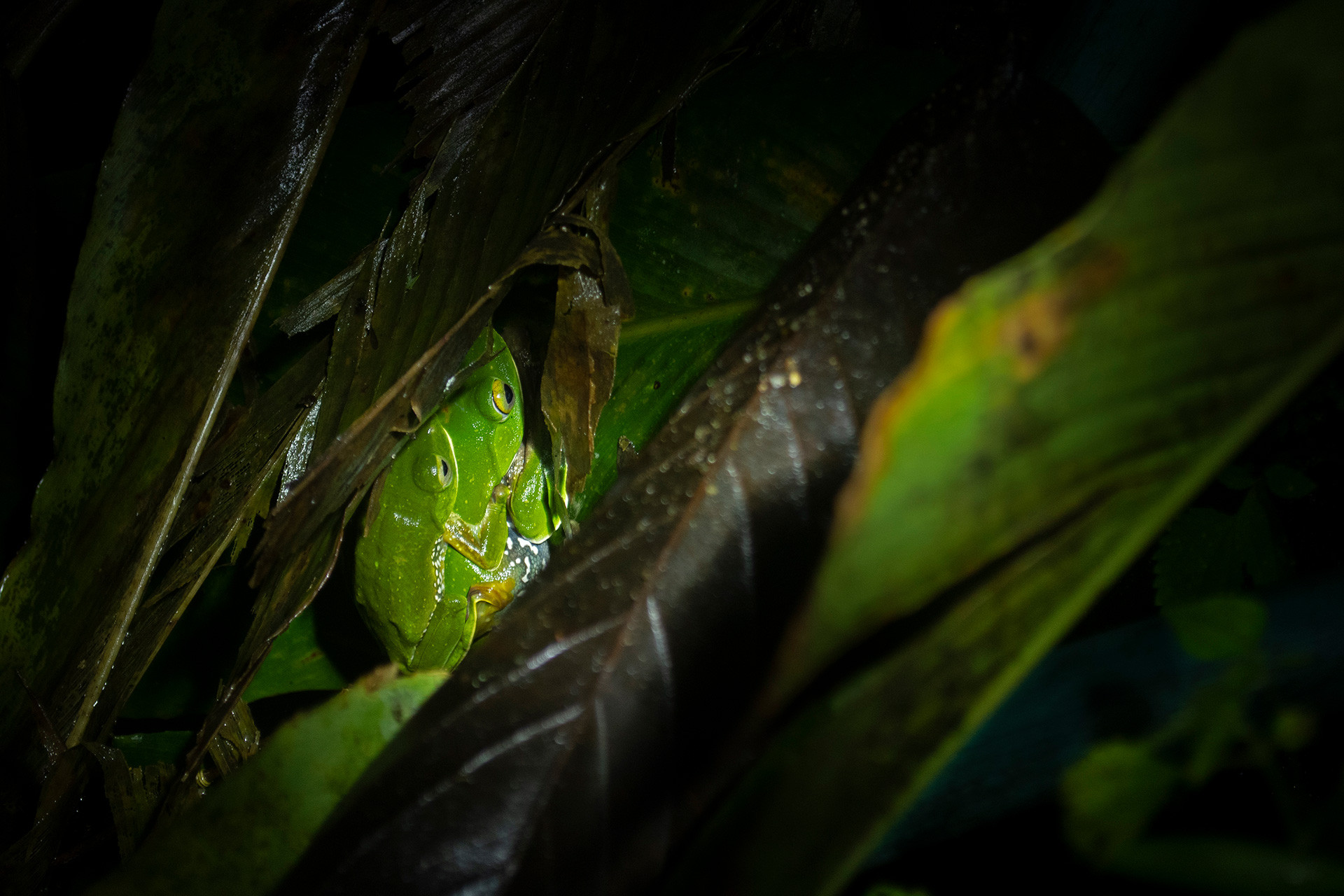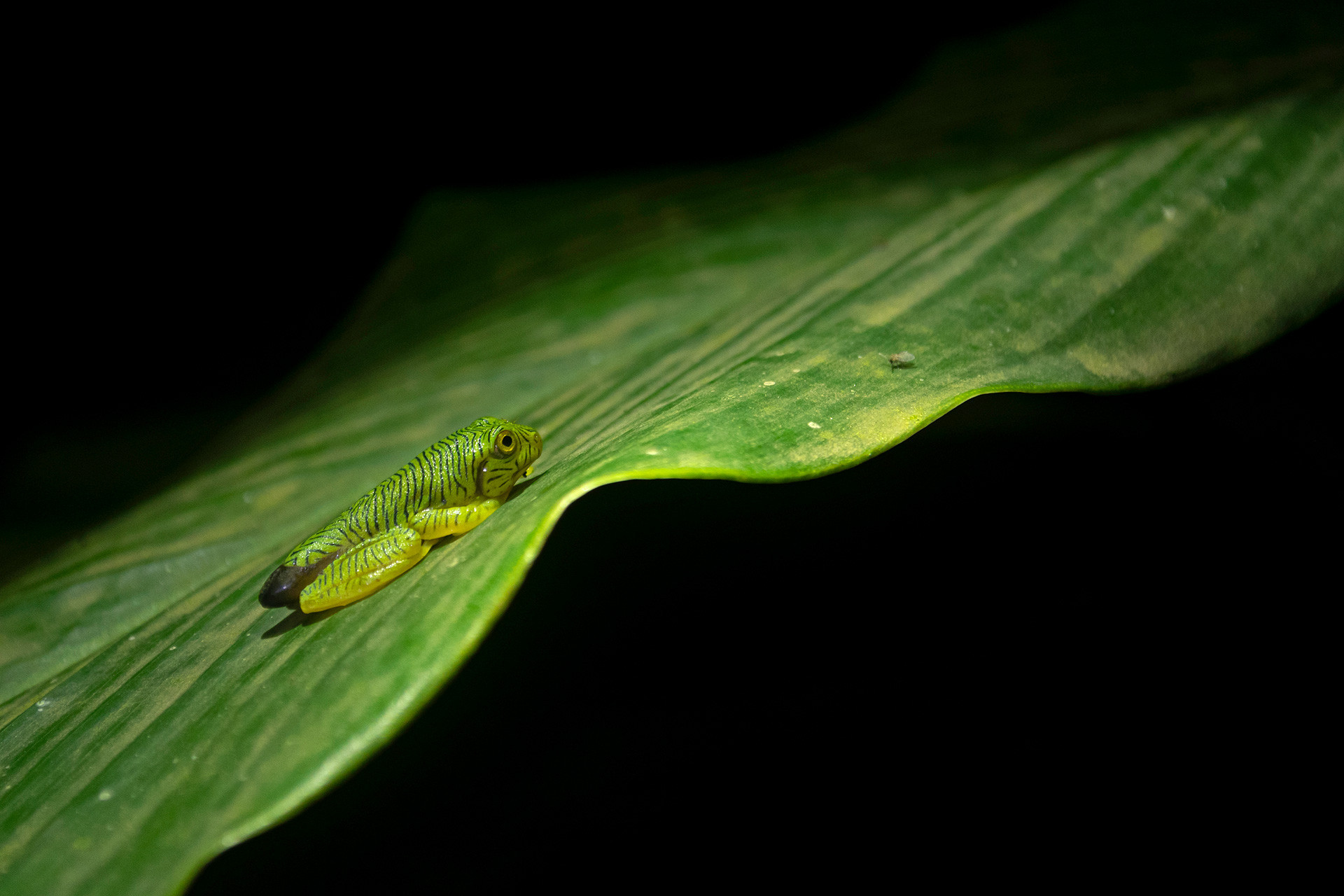On a wet July night in Munnar, deep within a shade-grown cardamom plantation, a loud “trr tik tik tik tik trrr” emanates from a water tank—a green frog with bright yellow eyes calls through pauses in the southwest monsoon rains in search of a mate. The sheaves of cardamom leaves hanging above the water tank are already wrapped together by thick foam carrying the fertilised eggs of his successful peers. The foam dissolves at the touch of the rain, allowing the tiny tadpoles ensconced within to slide into the water. These tadpoles, if they survive the perilous journey through water and land, will eventually venture into the trees as mature Anaimalai Flying Frogs.
The Anaimalai Flying Frog is one of four gliding frogs endemic to the Western Ghats. They belong to a genus of arboreal frogs characterised by highly developed webbing on their limbs, which helps them effortlessly glide down from treetops. Glowing green under torchlight, this frog is sometimes confused with the more common Malabar Gliding Frog (Rhacophorus malabaricus)—a similarity that earned it its scientific name of R. pseudomalabaricus. They can be distinguished however by a quick look at their flanks—the Anaimalai Flying Frog or False Malabar Gliding Frog has a white-mottled, dark brown stripe in place of the solid green on its Malabar counterpart.
Anaimalai Flying Frogs find their natural habitat in the montane wet evergreen forests of the Western Ghats, such as those in the Anamalai Hills. They have also been recorded in plantations around Munnar. Despite their arboreal nature, these frogs require stagnant water bodies to reproduce. During the breeding season, pairs can be seen in amplexus (mating) on the vegetation surrounding ponds. Multiple males try to mate with a much larger female, vying to fertilise the eggs she lays within a foamy nest. The female then carefully covers the nest with leaves—the rains will wash the tadpoles into the pond over the next few days.
As they grow, the tadpoles develop a green coat with black stripes that is retained in the limbed juveniles; this patterning mimics the venation on leaves, making it easier for the young adults to camouflage themselves. The stripes fade as they mature, leaving the adults with parrot-green skin, pockmarked in pale yellow.
Anaimalai Flying Frogs traverse different landscapes like few other species can, moving through aquatic, terrestrial and arboreal habitats through their lives, always capable of gliding/climbing from one to another. However, owing to increased tree felling, road expansions, and the conversion of natural forests into plantations, they are now considered ‘Critically Endangered’. Even their adapted existence in human-modified landscapes such as plantations is threatened by local perceptions of them as bad omens. Believed to feed on cardamom fruits, they are perceived a threat to commercial cardamom harvest—a view that could not be further from the truth as their insectivorous diet could, in fact, help regulate potential pests. Yet, this myth continues to circulate among people in the agroforestry community, blocking the path towards amphibian conservation.
On a guided tour through a plantation in Munnar, Hadlee Renjith (a naturalist and herping guide) walked us through the entire life cycle of the Anaimalai Flying Frog centred on an abandoned irrigation tank. These frogs may have carved out a niche for themselves in the trees but they gather by this pond every monsoon to breed—its presence is critical for their survival. Since he spotted the first Anaimalai Flying Frog here, Hadlee has received support from the Wildlife Trust of India to trigger a rapid action conservation project targeting amphibians. Through this venture, he and his team have set up artificial water tanks that these frogs can use to reproduce within cardamom plantations. They have also involved plantation supervisors in this endeavour, requesting them to allow the undergrowth to flourish around their cardamom crop. Since the construction of the tanks, Hadlee has observed sustained gliding frog activity at these sites.
Cardamom plantations cover roughly 30,000 to 40,000 hectares of land in Munnar. If more such spaces can be created and consistently maintained within these plantations, it could go a long way in ensuring the continued survival of the Anaimalai Flying Frog and other endangered amphibians.







